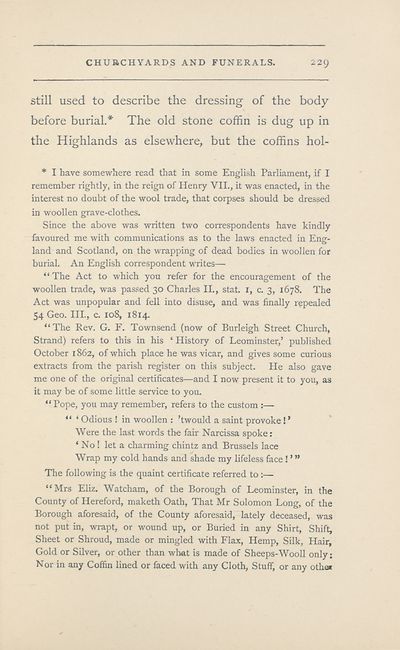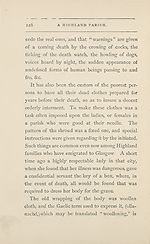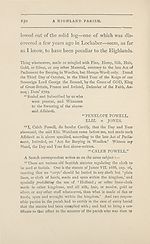Download files
Complete book:
Individual page:
Thumbnail gallery: Grid view | List view

CHURCHYARDS AND FUNERALS.
229
still used to describe the dressing of the body
before burial.* The old stone coffin is dug up in
the Highlands as elsewhere, but the coffins hol-
* I have somewhere read that in some English Parliament, if I
remember rightly, in the reign of Henry VII., it was enacted, in the
interest no doubt of the wool trade, that corpses should be dressed
in woollen grave-clothes.
Since the above was written two correspondents have kindly
favoured me with communications as to the laws enacted in Eng¬
land and Scotland, on the wrapping of dead bodies in woollen for
burial. An English correspondent writes—
“ The Act to which you refer for the encouragement of the
woollen trade, was passed 30 Charles II., stat. 1, c. 3, 1678. The
Act was unpopular and fell into disuse, and was finally repealed
54 Geo. III., c. 108, 1814.
“The Rev. G. F. Townsend (now of Burleigh Street Church,
Strand) refers to this in his ‘ History of Leominster,’ published
October 1862, of which place he was vicar, and gives some curious
extracts from the parish register on this subject. He also gave
me one of the original certificates—and I now present it to you, as
it may be of some little service to you.
“ Pope, you may remember, refers to the custom :—
“ ‘ Odious ! in woollen : ’twould a saint provoke! ’
Were the last words the fair Narcissa spoke:
‘ No ! let a charming chintz and Brussels lace
Wrap my cold hands and shade my lifeless face ! ’ ”
The following is the quaint certificate referred to:—
“Mrs Eliz. Watcham, of the Borough of Leominster, in the
County of Hereford, maketh Oath, That Mr Solomon Long, of the
Borough aforesaid, of the County aforesaid, lately deceased, was
not put in, wrapt, or wound up, or Buried in any Shirt, Shift,
Sheet or Shroud, made or mingled with Flax, Hemp, Silk, Hair,
Gold or Silver, or other than what is made of Sheeps-Wooll only:
Nor in any Coffin lined or faced with any Cloth, Stuff, or any other
229
still used to describe the dressing of the body
before burial.* The old stone coffin is dug up in
the Highlands as elsewhere, but the coffins hol-
* I have somewhere read that in some English Parliament, if I
remember rightly, in the reign of Henry VII., it was enacted, in the
interest no doubt of the wool trade, that corpses should be dressed
in woollen grave-clothes.
Since the above was written two correspondents have kindly
favoured me with communications as to the laws enacted in Eng¬
land and Scotland, on the wrapping of dead bodies in woollen for
burial. An English correspondent writes—
“ The Act to which you refer for the encouragement of the
woollen trade, was passed 30 Charles II., stat. 1, c. 3, 1678. The
Act was unpopular and fell into disuse, and was finally repealed
54 Geo. III., c. 108, 1814.
“The Rev. G. F. Townsend (now of Burleigh Street Church,
Strand) refers to this in his ‘ History of Leominster,’ published
October 1862, of which place he was vicar, and gives some curious
extracts from the parish register on this subject. He also gave
me one of the original certificates—and I now present it to you, as
it may be of some little service to you.
“ Pope, you may remember, refers to the custom :—
“ ‘ Odious ! in woollen : ’twould a saint provoke! ’
Were the last words the fair Narcissa spoke:
‘ No ! let a charming chintz and Brussels lace
Wrap my cold hands and shade my lifeless face ! ’ ”
The following is the quaint certificate referred to:—
“Mrs Eliz. Watcham, of the Borough of Leominster, in the
County of Hereford, maketh Oath, That Mr Solomon Long, of the
Borough aforesaid, of the County aforesaid, lately deceased, was
not put in, wrapt, or wound up, or Buried in any Shirt, Shift,
Sheet or Shroud, made or mingled with Flax, Hemp, Silk, Hair,
Gold or Silver, or other than what is made of Sheeps-Wooll only:
Nor in any Coffin lined or faced with any Cloth, Stuff, or any other
Set display mode to:
![]() Universal Viewer |
Universal Viewer | ![]() Mirador |
Large image | Transcription
Mirador |
Large image | Transcription
| Antiquarian books of Scotland > Scotland/Scots > Reminiscences of a Highland parish > (241) |
|---|
| Permanent URL | https://digital.nls.uk/109514342 |
|---|
| Description | Thousands of printed books from the Antiquarian Books of Scotland collection which dates from 1641 to the 1980s. The collection consists of 14,800 books which were published in Scotland or have a Scottish connection, e.g. through the author, printer or owner. Subjects covered include sport, education, diseases, adventure, occupations, Jacobites, politics and religion. Among the 29 languages represented are English, Gaelic, Italian, French, Russian and Swedish. |
|---|

